#kimjang kimchi
Text
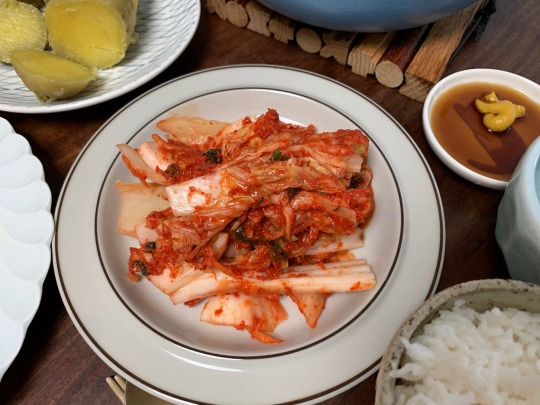

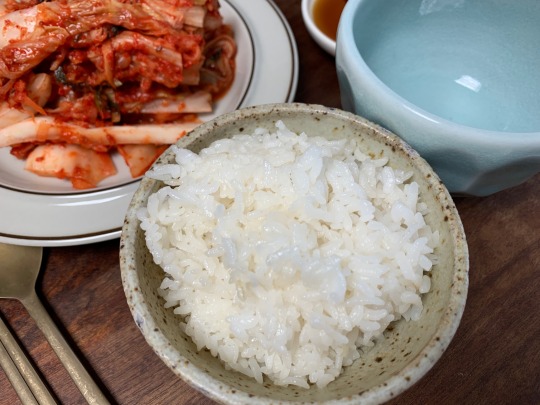
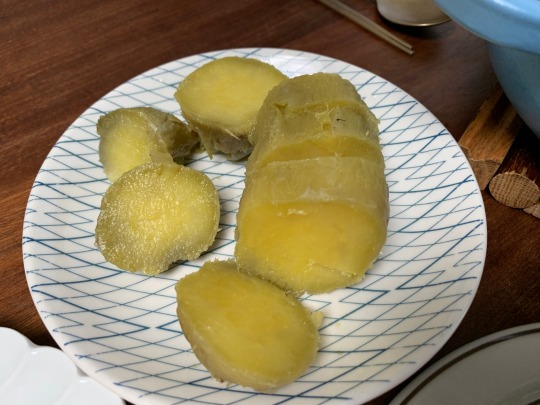

@인왕별장
#food#korean food#lunch#kimchi#banchan#점심#오뎅탕#가성비값#하코야#원소주#이밥#김장김치#고구마#럭셔리하다#윈터스페샬#sweet potatoes#kimjang kimchi#soju
21 notes
·
View notes
Text
A semi-unhinged rant about kimchi (and what makes it authentic)
With the influx of white people liking Korean food... there is also an influx of white people not understanding the basics of Korean food. And it frustrates me immensely as a Korean this is so. When you don’t spend time understanding the hows and whys of dishes before trying to “recreate” them--it create problems with your results. And you might be thinking: But do you do this with other regionalities of food? And to this I say, ABSO-FUCKING-LUTELY. I spent a month alone researching Indian pickle. And still, still understood mine wasn’t “superior” and that I got bits wrong. And you know what? I tried it again, asked, and tried yet again. And when faced with Indian people in front of me, didn’t boast how mine was somehow “better”
I’m sure someone is about to chime in and say, “BUUUUUTT YOU’RE ADOPTED.”
And to that person, I say: Sit down and shut up.
I still have memories of my grandmothers’ cooking. I still have a memory of taste of Eomma’s kimchi hardwired into my brain. I still can taste the bungeoppang from Iksan market. I still remembered the exact taste of a Korean apple and can describe it to you and how it differs from the US counterparts. So no, this is one case where I know what I’m talking about.
For those not invested in kimchi, specifically, this will go into Korean food psychology too, and other useful topics you might need to know.
Sorted Foods argued that white-made “Kimchi” with a different process could still be called kimchi, and no. Not if it doesn’t honor the spirit of the dish. (Jamie was correct.)
https://www.youtube.com/watch?v=OI2hFekaRlc
Let’s be clear here: I have no problem with people making kimchi who aren’t Korean. But I’d prefer that people actually learn from a Korean and then understand the function of the ingredients before complaining about the existence of said ingredients. And once they do that, to NOT under any circumstances, mark it up and then put a metal lid on it because you don’t understand the function of the dish.
So I’m going to do this for you with basic run downs in the following areas:
The cultural psychology of Korean food
The food science behind kimchi (This is something Koreans also forget)
The intention of kimchi
But, but the Diaspora?
Why White people’s (commercial) kimchi often messes up and fails to understand
How to tell authentic Kimchi from inauthentic Kimchi vs. Kimchi snobbery.
The cultural psychology of Korean food
Five Colors
https://www.gastrotourseoul.com/the-five-colors-of-korea-what-do-you-know-about-o-bang-saek/
I should note that current scientists actually support this idea thousands of years after Chinese and Korean enforced this. For reference, Korean enforce this idea more than Chinese (Han) do.
Five Flavors
https://ling-app.medium.com/5-flavors-in-korean-a-secret-to-delicious-k-food-9425a240276a
This is where you can find an article on the five flavors. Originally from Chinese Han people, but Koreans enforce this more than Chinese do.
Fermentation process is different from other regions
The majority of Korean fermentation deals with aerobic fermentation. I get this scares the crap out of most white people. But trust me when I say that Koreans have it down and there is a reason for this psychology.
Paochai is anaerobic. Tsukemono is anaerobic. Sauerkraut is anaerobic. kimchi out of the majority of fermented vegetables is an aerobic process and was designed to be very, very carefully over thousands of years.
Likewise with soy sauce, Koreans do the aerobic version, while everyone else does anaerobic. This is true across the board for traditional Korean processes that doesn’t always hold true for other versions.
The obsession with the removal of the smell of food
Koreans have this obsession with removing the smell of food. This is why the onggi/hangari are designed to BREATHE. They release gasses through the earthenware surface and are beaten in a certain way so that if you sealed the top, the jar itself is still breathing. This releases certain kinds of gas which make the taste of kimchi the taste of kimchi.
Koreans do this with meats (remove the smell of meat by washing it) Also do it with fish, etc. (Some people might recognize some of it as semi-koshering the meat/fish too--some of the process is similar and I think it’s for similar reasons--avoiding bacterial infections in a time before refrigeration. But this is a loose theory, rather than fact.)
And certainly in the fermentation process.
The food science behind kimchi (This is something Koreans also forget)
Onggi is a jar that breathes. It’s designed to breathe. They are expensive, I know, but it’s really, really worth your investment if you want to do any kind of Korean fermentation. Onggi releases the bad gasses that cook the kimchi’s vegetables into mush. With sauerkraut, it is designed to semi-cook under the fermentation process. With kimchi it is not supposed to cook at all, and through this the vegetables in question stay crunchy.
How do I know this? I make kimchi and have gotten it “wrong” on purpose a number of times in a number of ways just to crack the food science.
This said, there are several basic parts to Kimchi’s elements:
You have the vegetables, which don’t have to be nappa. It can be mu (white radish) These are usually high in vitamin C. You can have mountain herbs and a whole host of other ingredients in this section. If the person is skillful and there are multiple ingredients in the jar, they will figure out how to stack the interior of the jar so that certain vegetables are at the top.
Salt
The best salt is flower seasalt, which you can get in bulk. It has a slightly sweet taste to it. In a punch finely ground kosher is OK, but keep in mind that Kosher salt is saltier. (some people use MSG too... but I find it wholly unnecessary as the cabbage and seafood elements has MSG naturally in it)
The salt acts as a preservative and helps bring out that unique crunch. It prevents bad bacteria from growing in the kimchi.
The sweet rice flour/wheat flour
This attracts the lactobacilli. The majority of winter kimchi uses sweet rice flour. This is not added sugar, BTW, it’s the varietal of rice.
It gives it food. Since sweet rice flour has more sugar content in the form of starch (muslimintp-1999-girl's correction, not gluten), etc, this is why it is used in winter. Whereas yeolmu kimchi uses wheat flour, which has less gluten/food for the lactobacilli.
BTW, for those that add jujubes, this is also their function. Sugar is sometimes applied, especially to Seoul Kimchi, but it’s only traditional to the Japanese occupation. In older recipes that do use this type of starter, especially for winter kimchi, they use sliced Asian pears, pear juice, or jujubes. However, this is seen more of a “King’s Kimchi” and was for the “upper class.” rather than the lower classes. So it’s unlikely the nobi (slave class) was able to eat such kimchi. The reason raw sugar, and sugar cane in general isn’t considered really “traditional” by kimchi snobs, is because sugar cane itself grows in tropical regions and was a Portuguese import. For times when sugar *is* applied, Koreans tend to reduce the amount of sweet rice flour to compensate. lactobacilli eat raw sugar quickly, so for summer and more southern on the Korean peninsula kimchi, cane sugar is not used.
Protein element
The protein is like a stop sign to the lactobacilli and tells them to SLOW DOWN. Eat that starch more slowly. So protein can include shrimp paste (usually sweet June shrimp), anchovy paste, mussels, clams, and oysters. Occasionally, depending on the region they also include crabs. (Eomma’s Kimchi had crabs in it).
*Some* summer kimchi substitutes the sweet rice flour for wheat flour. Monk Kimchi (which still tastes strong due to the hard water) uses barley flour as well.
Lactobacilli also has been shown to eat gluten more slowly, which means it also eats protein as well. (This is true in soy sauce somewhat in the early stages, though another bacteria does the main action.)
Spices
The kochukaru... is designed to be spicy and sweet in keeping with the five flavors psychology. It is also specifically bred to stain *everything* so you can see when the vegetable is clearly coated properly.
There is a kimchi said to be made with sichuan peppers instead of kochukaru. (Dae Jang Geum kimchi), but you need more ingredients to balance out the flavors according to the five flavor theory. (Who spent several days combing through Dae Jang Geum kimchi for this? *rasies hand* I did. I back engineered the recipe.)
The garlic has been shown to control bacteria in studies and experiments. It is used worldwide this way.
Ginger also is meant to control bad bacteria.
The other flavorants are usually there to boost favors. soy sauce is very, very rarely used and vinegar is NEVER used in kimchi. Also, for those thinking the gochujang belongs in kimchi--no. Not kimchi. Buty gochugaru.
The design of kimchi, when made right is that it will not go mushy even left for a year. And they’ve found traces of kimchi in 3,000 year old jars.
The important part of the elements that go into kimchi is that there is a balance.
Kimchi will also bubble happily when fermenting. Exploding kimchi isn’t fun.
The intention of kimchi
There are a few key intentions, but is basically summarized like this: Poor people’s food and a healthy source of vitamins for long vegetable storage.
Anything that goes against this spirit isn’t kimchi.
But, but the Diaspora?
I’ve had North Korean kimchi and Brazilian kimchi made by Korean diaspora, and also watched videos--the elements remain the same even if the specific ingredients shift. The diaspora does not mess with the basics of the food science.
Why White people’s (commercial) kimchi often messes up and fails to understand
- Metal lid jars
goes against the “remove bad smell” idea and also goes against “do not cook kimchi through the fermentation process.”
Metal was expensive in Joseon and a limited resource. So no. And secondly “Seal it tight” “so I can’t smell it” is such a white person’s psychology. Make sauerkraut instead.
- The “make it milder”
why not eat white kimchi which has a specific balance that makes up for the lack of spices instead? (3 tbsps of gochugarui--I laugh) We mastered it already--why not eat that?
- Cutting the seafood element and not replacing it with protein
Ignores that the flour element will cook the kimchi and make it ferment unevenly. It’s not just there for long shelf life, you know. It’s there because it really truly does help it to ferment more evenly so you don’t have to stir it so often.
When I cut the seafood element, the kimchi fermented much, much faster, even in an onggi, turned sour much faster and went rotten a lot faster than I intended.
- Add strange ingredients
Crap like “Quinoa” and other “make it healthier” foods that mark up the price of the kimchi. Adding things like cayenne and paprika are out. I can kinda forgive spicier peppers, but those are NOT a substitute for gochugaru. “Miso” is a WTF ingredient. They should have used barley. With properly fermented kimchi, soy sauce, etc, the gluten should be consumed by the lactobacilli.
https://www.ncbi.nlm.nih.gov/pmc/articles/PMC5494637/#:~:text=This%20study%20demonstrated%20that%2010,hydrolyze%20gluten%20under%20gastrointestinal%20conditions.
Which is what this study says. If they don’t consume the gluten, you’ve done something wrong.
- Cutting it into shreds...
--;; The size of the kimchi is designed to be cut that way for a reason. Whole kimchi preserves longer than cut kimchi.
- The mark up in price
Again, POOR PEOPLE’S food. You can’t improve it. Koreans improved it over thousands of years and without microscopes, etc figured out all of the info I gave (though some of us, admittedly have amnesia about the why.)
The only exception to the “poor people’s food” is King kimchi. But in that case, the person is controlling it under very specific conditions and doing it extremely to tradition and a historical recipe, including making their own fish sauce, etc, in which case the mark up is justified.
How to tell authentic Kimchi from inauthentic Kimchi vs. Kimchi snobbery.
Authentic kimchi should hold its crunch, sourness, and be slightly sweet despite that. If it is a spicy kimchi, the gochugaru should taste sweet, but not punch you in the face.
The process is always aerobic, and for those that don’t like the smell--too bad. If you’re going to complain, maybe rethink if you want to make kimchi?
Inauthentic kimchi is BLAND. It is SOFT. It has no crunch. It doesn’t balance the flavors thoughtfully. It feels chucked in. And it’s marked up to extreme levels.
For the kimchi snobbery
- insisting that it is made in onggi (but that is superior)
- Insisting on particular kinds of garlic
- insisting on Korean ginger
- Being particular about the seafood and other ingredients that go in
- choosing premium salt
- Having a special kimchi-making bowl. (That’s me)
- Willing to fight to the death over how to make kimchi “right” per region.
- Talking about differences in fish sauce.
- refusing sugar, which is not native to Korea.
- There is a woman that grows her own nappa, uses a King’s recipe, and makes her own fish sauce because she thought the fish sauce on the market was wrong for what she wanted to create. That is premium and justifies a mark up in price.
Koreans follow the food science principles. But not everyone cares that much about the particular elements that go in. See, there is a separation. Koreans do everything in kimchi for a particular reason.
7 notes
·
View notes
Photo
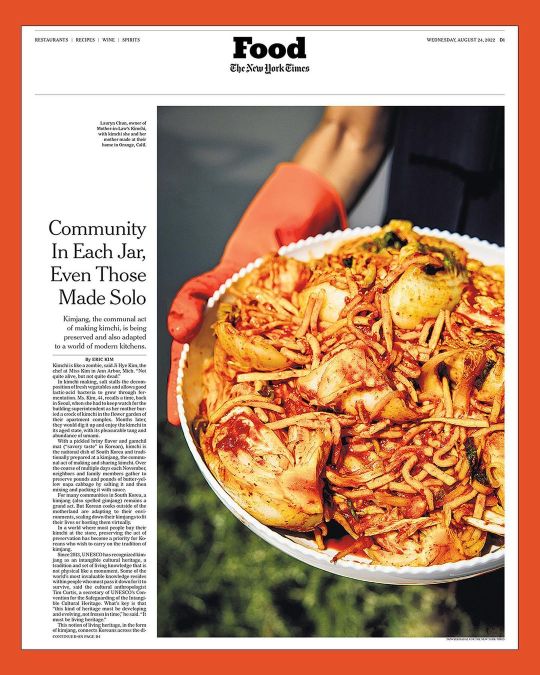
“If you can make a salad, you can make kimchi,” argues @ericjoonho in the cover story of today’s @nytimes Food section. I photographed kimjang, the communal act of making and sharing kimchi, with @milkimchi on a hot and spicy afternoon in Los Angeles. Thank you, @kgoug! #kimchi #kimjang #nytimes #onassignment https://www.instagram.com/p/Chpx5hlPQ-S/?igshid=NGJjMDIxMWI=
0 notes
Text
Side Dishes in Korea
Why do we get served so many each meal?
1. Background Information
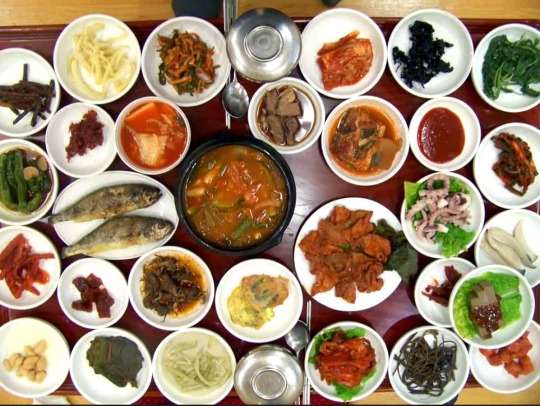
One of the most appealing things about eating out in Korea is the unlimited free refill on the side dishes, known as banchan.
This practice is deeply rooted in Korean history and character as a nation
2. Kimchi

There are hundreds of different types of kimchi, but the signature cabbage banchan is offered at pretty much every restaurant.
Koreans have for generations been storing vegetables in pots to ferment so that they will have food available for the winter.
3. Common Banchans
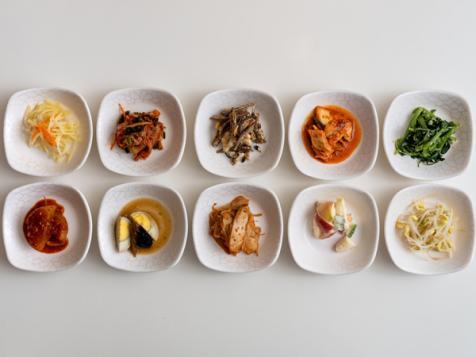
Other than kimchi, there are bean sprouts, cucumber vegetables, and sesame leaves pickled in soy sauce.
Some of the more luxurious Korean restaurant sever egg rolls, tteokbooki, and ganjang gejang.
4. Banchans At Restaurant

Eating at a Korean restaurant is always an exercise in how to maneuver all the dishes to actually fit on the table.
It is not uncommon to receive 3 or more different banchan dishes alongside the main course that you order.
5. Homemade Banchans

During a kimchi-preparation event called kimjang, a large amout of kimchi is laid out for all members of the family work on.
This practice is less common these days, but parents still like to prepare kimchi and distribute it to their children as a show of affection.
6. Why Are Banchan Unlimited?

One reason is that white rice was much more expensive than kimchi and banchan during difficult times in the Korean economy.
It was too expensive for restaurants to give refills of rice, but in order to make sure you were full, they offered you a second helping of banchan.
7. How Is Banchan Served?

In order to reduce operating costs, some restaurants have suggested limiting or removing the unlimited banchan options, which many Korean people weren’t happy about.
To meet in the middle, many Korean restaurants these days have adopted a self-service system in which you can eat as much as you like, but you have to approach the food station and fill your own bowls.
#korean food#korean headers#korean culture#korean banchan#banchan#korea banchan#Korean Guide#Korean lifestyle#korean eats#korean restaurant#korean resources#korean tips#korean vlog#korean blog#korean#korea food#korea guide#korea headers#korean kimchi#korea kimchi#korea lifestyle#korea eats#Korea Republic#korea restaurant#korea resources#korea tip#korea culture#korea vlog#korea blog#korea
162 notes
·
View notes
Text
On dancing
The dances I enjoy most in videos are those that seem spontaneous, those that seem like someone could do naturally while they walk or cook or search for a book in their room. (They're never natural, but the point is that they look natural.)
Here are two examples. The first is Elliot Page's dance from The Umbrella Academy (from 1:07).
youtube
The second is the dance from "Ophelia" by The Lumineers (from 1:56).
youtube
A bonus example: the dance from "Genghis Khan" by Miike Snow (from 2:32). It somehow feels both spontaneous and extremely choreographed; I can't help liking it.
youtube
(The dances which half•alive have are also great, but are too intentional, almost---I could never imagine anyone spontaneously moving in that way. But there is also a place for intentionality; there is always a place for everything.)
Sometimes, overwhelmed by something, I find myself naturally moving or responding. When I entered the Metropolitan Museum, I cried; the person with me had to stop for a moment and asked if I was alright. I couldn't describe it properly: I was just overwhelmed by the amount of culture in front of me.
When I found out that kimjang (making and sharing kimchi in the Republic of Korea) was recognised by UNESCO as part of the Intangible Cultural Heritage of Humanity, I found my feet naturally moving in happiness. Sometimes when I wake up and am still quietly preparing breakfast in the kitchen, something as simple as putting back the pots or pouring oats or making tea will make me dance because I'm alive.
I only do this when there isn't anyone else around. Sometimes it feels a little silly, even just doing this by myself. I don't know why I do these things, and I do them badly, and I feel like I should stop. But I simply cannot help myself. And I keep moving.
#dancing#there's a metaphor here somewhere#even I don't know what it is#inspired by a line from Thomas Browne
10 notes
·
View notes
Text
Watch "김장인가? 먹방인가? [민주쌤육아일기]" on YouTube
Kimjang: make kimchi with a mother
0 notes
Text
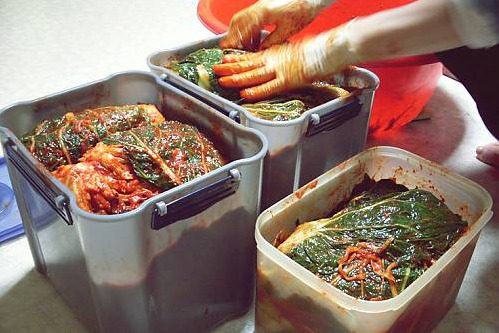
It's Kimjang season! According to the UNESCO site: Late autumn is Kimjang season, when communities collectively make and share large quantities of kimchi to ensure that every household has enough to sustain it through the long, harsh winter. Housewives monitor weather forecasts to determine the most favourable date and temperature for preparing kimchi. Innovative skills and creative ideas are shared and accumulated during the custom of exchanging kimchi among households.
0 notes
Photo

Gimjang or 김장 (sometimes written kimjang) is the traditional method of making and preserving kimchi, the spicy Korean meal made from fermented vegetables. Kimchi is a staple of Korean cuisine and can be consumed as a side dish with practically any meal. Seoul has established the only kimchi museum in the world, where visitors and locals can try several varieties of the fermented food and see how the traditional gimjang method works. For the first time in 8 years I had the opportunity to make my own kimchi! Which was delicious by the way!♡ I totally reccomend to try to make it once in your life. This is a rewarding experience! #koreanfood #koreancookingclass #lifeinkorea #koreanculture #visitkorea #koreatrip #koreatravel #koreatravelguide #요리 #쿠킹클래스 #김치 #김장철 #김장 #파이팅 #✌️ #kimchi #한국음식 #깍두기김치 #배추김치 (at 성수동) https://www.instagram.com/p/Cl-RuDAP6hv/?igshid=NGJjMDIxMWI=
#koreanfood#koreancookingclass#lifeinkorea#koreanculture#visitkorea#koreatrip#koreatravel#koreatravelguide#요리#쿠킹클래스#김치#김장철#김장#파이팅#✌️#kimchi#한국음식#깍두기김치#배추김치
0 notes
Video
youtube
KOREA / Making KIMCHI with Traditional Recipe / KIMJANG
oday’s video is about Making Kimchi with traditional recipe, “Kimjang” This is a major event of making Kimchi for the winter. I hope You guy would enjoy the video,and Find out the value Kimjang is for Korean’s:-)
#kimchi#making kimchi#kimjang#korean kimchi#how to make kimchi#traditional kimchi#kimjang kimchi#korean cooking
4 notes
·
View notes
Photo
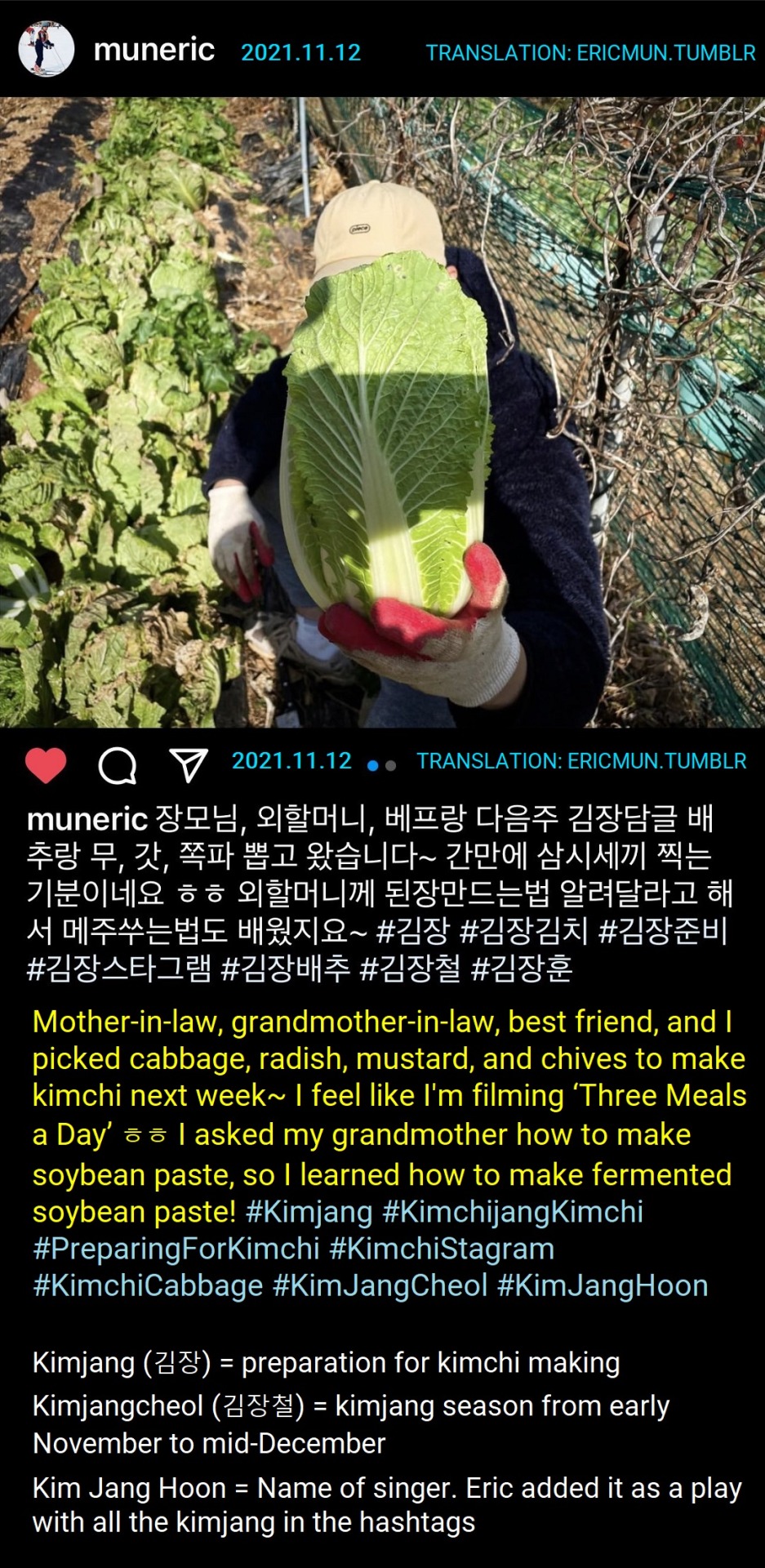
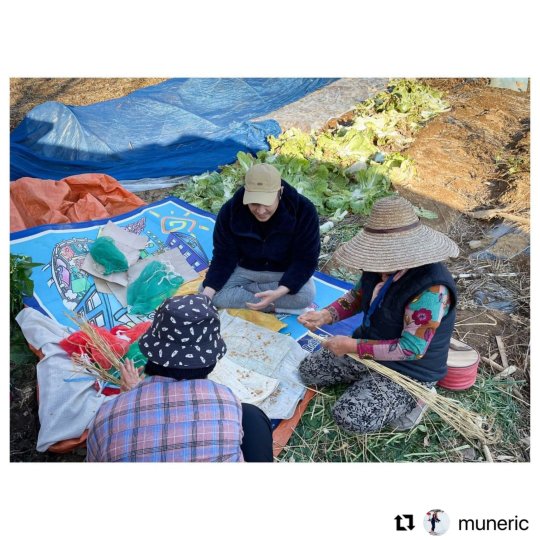
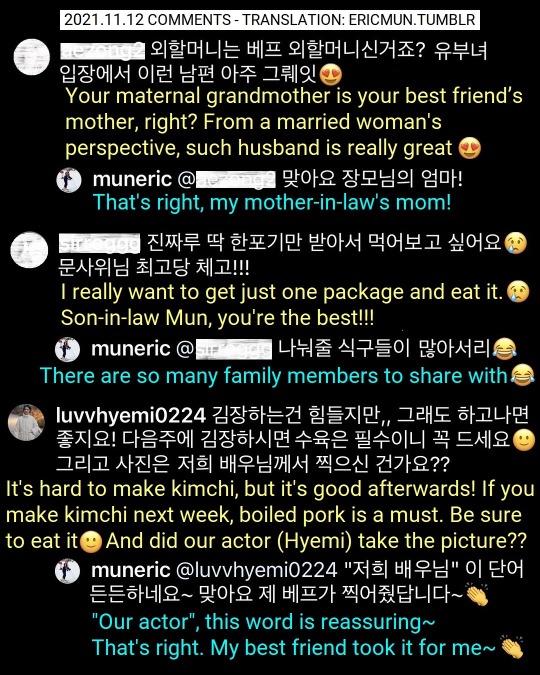

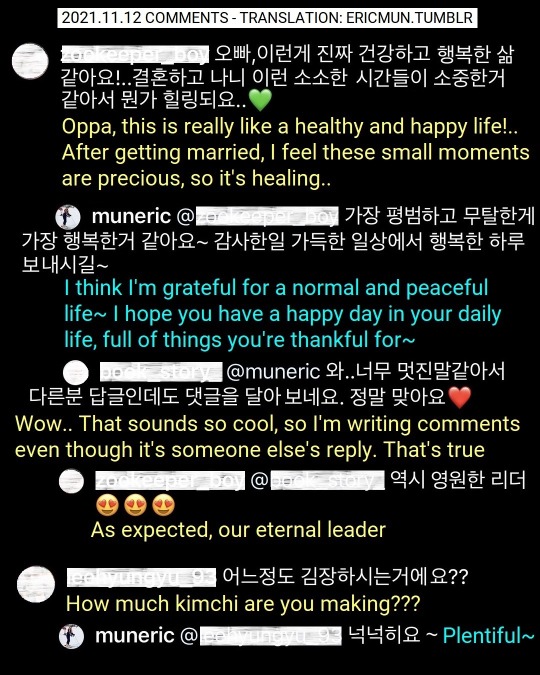
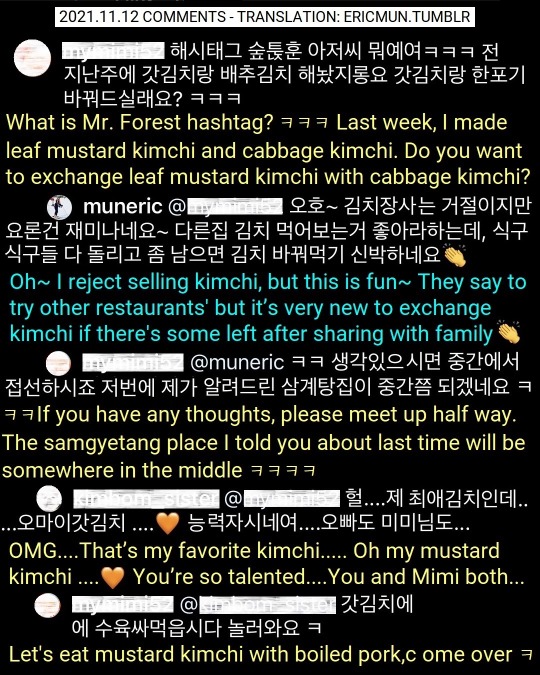
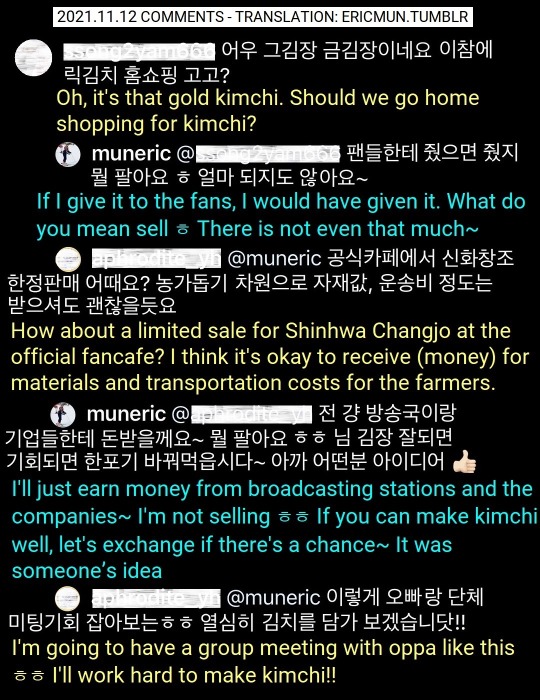
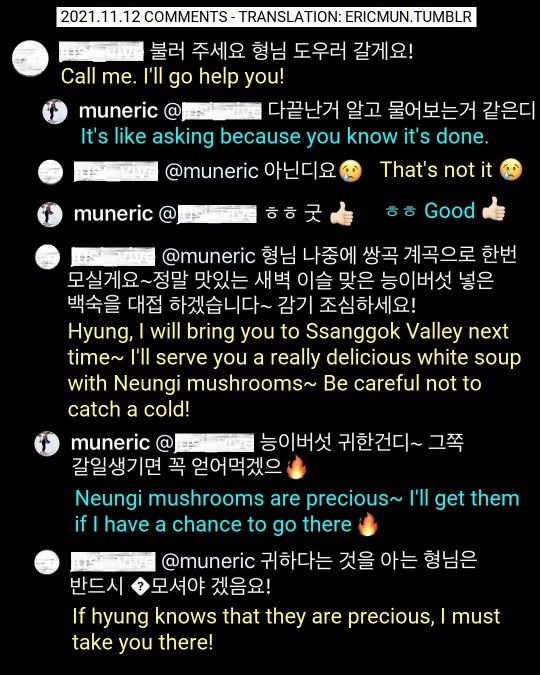
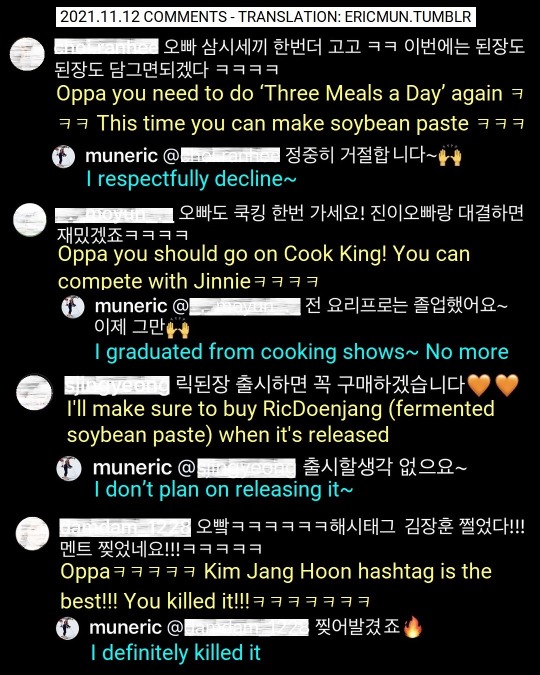

2021.11.12 Shinhwa’s Eric Instagram Update #1
Mother-in-law, grandmother-in-law, best friend and I picked cabbage, radish, mustard, and chives to make kimchi next week~ I feel like I'm filming ‘Three Meals a Day’ ㅎㅎ I asked my grandmother how to make soybean paste, so I learned how to make fermented soybean paste! #Kimjang #KimchijangKimchi #PreparingForKimchi #KimchiStagram #KimchiCabbage #KimJangCheol #KimJangHoon
Kimjang (김장) = preparation for kimchi making
Kimjangcheol (김장철) = kimjang season from early November to mid-December
Kim Jang Hoon = Name of singer. Eric added it as a play with all the kimjang in the hashtags
Comments & Replies:
OP: Your maternal grandmother is your best friend’s mother, right? From a married woman's perspective, such husband is really great 😍
ERIC: That's right, my mother-in-law's mom!
OP: I really want to get just one package and eat it. Son-in-law Mun, you're the best!!! 😢
ERIC: There are so many family members to share with 😂
luvvhyemi0224: It's hard to make kimchi, but it's good afterwards! If you make kimchi next week, boiled pork is a must, so make sure to eat it. 🙂 And did our actor (Hyemi) take the picture??
ERIC: "Our actor", this word is reassuring~ That's right. My best friend took it for me~ 👏
OP: You’re a perfect husband 👏👏👏👏 I'm going to make kimchi next week ^^ Let's make it delicious ~~
ERIC: Making kimchi is hard. Respect~ Fighting 🔥
OP: You're Kim Jang “Hyuk” (play on Kimjang) ㅋㅋㅋ I also help my mom and make 100 cabbages of kimchi..... Oppa...hwaiting....
ERIC: We made about that much too ㅎ Fighting👏
OP: Thanks to you, I'm working hard on making kimchi 😍 Be careful from getting sick~🙌 Enjoy making kimchi with your wife! 👏
ERIC: Making kimchi is hard. Cheer up! 🔥
OP: Oppa, this is really like a healthy and happy life!.. After getting married, I feel these small moments are precious, so it's healing..💚
ERIC: I think I'm grateful for a normal and peaceful life~ I hope you have a happy day in your daily life, full of things you're thankful for~
OP2: Wow.. That sounds so cool, so I'm writing comments even though it's someone else's reply. That's true ❤️
OP: As expected, our eternal leader 😍😍😍
OP: How much kimchi are you making??
ERIC: Plentiful~
OP: What is Mr. Forest hashtag? ㅋㅋㅋ Last week, I made leaf mustard kimchi and cabbage kimchi. Do you want to exchange leaf mustard kimchi with cabbage kimchi? ㅋㅋㅋ
ERIC: Oh~ I don’t like selling kimchi, but this is fun~ They say to try other restaurants' kimchi, but it’s very new to exchange kimchi if there's some left after sharing with family 👏
OP: ㅋㅋ If you have any thoughts, please meet up half way. The samgyetang place I told you about last time will be somewhere in the middle ㅋㅋㅋㅋ
OP2: OMG....That’s my favorite kimchi..... Oh my mustard kimchi ....🧡 You’re so talented....You and Mimi both...
OP: Let's eat mustard kimchi with boiled pork. Come over. ㅋ
OP: Oh, it's that gold kimchi. Should we go home shopping for kimchi?
ERIC: If I give it to the fans, I would have given it. What do you mean sell? ㅎ There isn’t even that much~
OP2: How about a limited sale for Shinhwa Changjo at the official fancafe? I think it's okay to receive (money) for materials and transportation costs for the farmers.
ERIC: I'll just earn money from the broadcasting station and the companies~ I'm not selling ㅎㅎ If you can make kimchi well, let's exchange if there's a chance~ It was someone’s idea
OP2: I'm going to have a group meeting with oppa like this ㅎㅎ I'll work hard to make kimchi!!
OP: Call me. I'll go help you!
ERIC: It's like asking because you know it's done.
OP: That’s not it 😢
ERIC: ㅎㅎ Good 👍🏻
OP: Hyung, I will bring you to Ssanggok Valley next time~ I'll serve you a really delicious white soup with Neungi mushrooms~ Be careful not to catch a cold!
ERIC: mushrooms are precious~ I'll get them if I have a chance to go there 🔥
OP: If hyung knows that they are precious, I must take you there!
OP: Oppa you need to do ‘Three Meals a Day’ again ㅋㅋㅋ This time you can make soybean paste ㅋㅋㅋㅋㅋ
ERIC: I respectfully decline~🙌
OP: Oppa you should go on Cook King! You can compete with Jinnieㅋㅋㅋㅋ
ERIC: I graduated from cooking shows~ No more🙌
OP: I'll make sure to buy RicDoenjang (fermented soybean paste) when it's released.🧡🧡
ERIC: I don’t plan on releasing it~
OP: Oppaㅋㅋㅋㅋ Kim Jang Hoon hashtag is the best!!! You killed it!!!ㅋㅋㅋㅋ
ERIC: I definitely killed it 🔥
OP: Wow~ You even make kimchi yourself~~ Surprised~~ The expression "best friend" is really touching~~ I should call my husband best friend~
ERIC: Nudge, you should also play best friends with your husband~❤️
OP: ‘Three Meals a Day’ memories ㅜㅜ When will you enter Deukryangdo oppa?(?) Will you make soybean paste stew with fermented soybeans?(?)
ERIC: Deukryangdo NAVER❤️
OP2: Let’s go Deukryangdo 👏
T/N: When people want to say "never," sometimes they'll say "Naver" (Korean search engine) as a joke.
Source: muneric
Translation: EricMun.tumblr
#Shinhwa#Eric Mun#Eric Moon#Mun Jung Hyuk#Moon Jung Hyuk#Eric#Munstagram#Eric: IG#Family Outing#Kimchi#Kimjang#Gimjang#Kim jang cheol#Kim Jang Hoon#muneric#신화#에릭#문정혁#김장#김장김치#김장준비#김장스타그램#김장배추#김장철#김장훈
4 notes
·
View notes
Text
instagram
Welcme to My Kfood Channel ;)
1 note
·
View note
Text
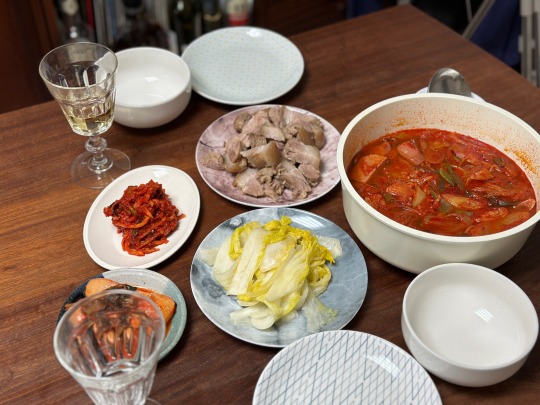
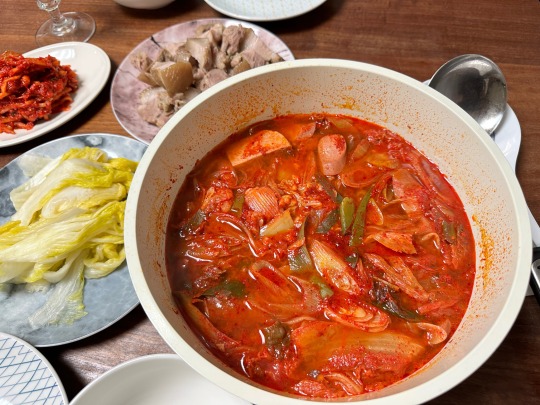

@인왕별장
#food#korean food#저녁#dinner#kimchi#banchan#인왕별장#김장#kimjang#gimjang#kimchi making season#부대찌개#경원식당#절인배추#수육
12 notes
·
View notes
Video
youtube
How to make Kimchi Kimjang/Gimjang|Top 5 Healthiest Food with Inday sa K...
https://youtu.be/Y2Hl7ZgfjtU
Tumaas ang export rate ng Kimchi sa Western Countries.Scientifically proven na ang health benefits ng Kimchi at naniniwala silang ang Kimchi ay isang healthy food na makakapagpalakas ng Immune System na makakatulong sa ating katawan para lababanan ang COVID-19.
This video of Inday sa Korea will show you how to make Kimchi. Kimchi is the most famous Korean traditional fermented superfood in Korea, recognized for its health benefits since ancient times. Gimjang, also spelled kimjang, is the traditional process of preparation and preservation of kimchi, the spicy Korean fermented vegetable dish, in the wintertime. Kimchi is one of the top five healthiest foods in the world according to American health magazine “Health.”Please don't forget to subscribe after watching it.
Thank youEnjoy watching and thank you for subscribing to Inday sa Korea Channel. Kamsahamnida♡♡
👇👇👇👇👇👇👇👇👇👇Like and Subscribe to my Channel @
Youtube: https://bit.ly/2ZGmD2X
Facebook Page: https://www.facebook.com/indaysakorea/
0 notes
Photo
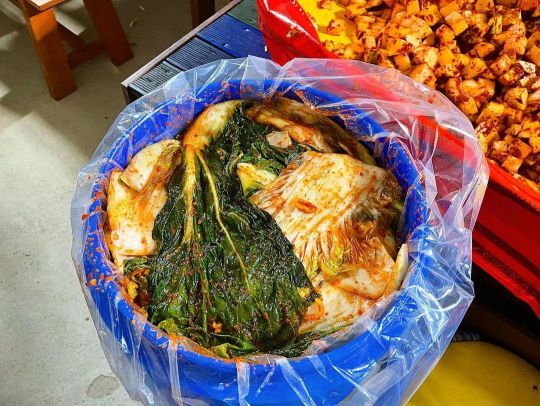
#20201106 🥬🥬🥩 김장하는날 수육대신 바베큐! :) #김장 #김치 #바베큐 #통삼겹바베큐 #웨버그릴 #WEBERgrills #KIMCHI #KIMJANG #KOREA #KOREANfood #KOREANkimchi(대자연농원에서) https://www.instagram.com/p/CH5aAr6B5W5/?igshid=1iuky2kzku1ku
0 notes
Photo
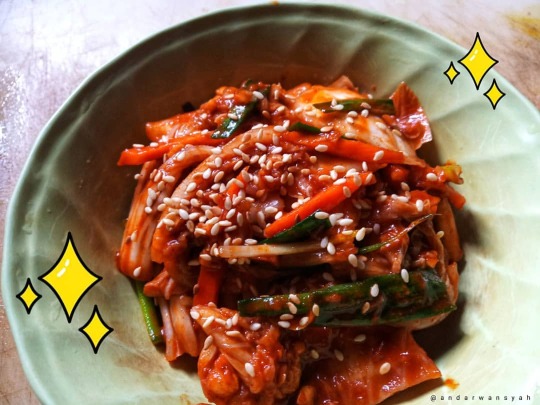
Hari ini bagi sebagian orang adalah hari rabu, hari libur atau hari raya nyepi (selamat merayakan 🤗), to me, today is Gimjang (김장), also spelled kimjang artinya hari membuat kimchi 🎉🎉🎉 so excited! . Kimchi adalah makanan fermentasi dan rasanya asam (sudah tau kan asalnya dari mana, yang suka nonton drakor atau yang baru nonton drakor karena efek #DiRumahAja pasti tau 😅). Bagi yang tidak familiar, kesan pertama akan seperti sayur basi (menurut sebagian besar temanku 🤣) . Kimchi bisa juga dimakan langsung atau masih fresh tanpa fermentasi loh gaess (see picture) namanya adalah Baechu-geotjeori (배추겉절이) or Quick, fresh kimchi . Kimchi ini akan menjadi teman makan aku selama #Lockdown, it's spicy, sour healthy and nutritious! 💕 . #Kimchi #Kimjang #KoreanFood #StayHealthyMyFriends (di Kota Timika Papua) https://www.instagram.com/p/B-I3JeUJfR4/?igshid=1czrfch6ridis
0 notes
Text
Watch "17개월 아기랑 김장이 가능할까?🥬 | 육아 겸 김장 브이로그" on YouTube
youtube
Idun's family Quartet kimjang (winter Kimci/very eco- friendly fermentation vegetable during the winter about 6 months) ■Kimjang: salted cabbages & wash off that salty cabbages ( andante)- variety ingredients-mixed everthing make harmony (moderato)-put ingredients vegitables with fermented fishes in side cabbages like Lasagna (largo)-finale: put in the containers and enjoying kimjan Kimchi with boiled pork belly and oysters ./( Allegro) I think this Koreans eco-friendly fermentation method is very important to world peoples who has cold weather or natural dester to human and no factories this eco' friendly kimchi make many kind cooking for family and sometime wash off kimch you can taste flavor without spicy taste. One oily food country imitation kimchi is their culture. Don't lie to the world and koreans don't know oily food like you and everything seed's island peoples and some partners don't fake to peoples anymore. If anyone attack our mountain Baekdu or Gawondo province will go to Hades. Korea's land and culture are belong to Korean and nazi who give pain to Israel peoples because they ate bread while Germany was inflation and made Germans with false story and gave them hard time were sin. UN is law so they can't attack easily so put Japan and China and Russia out is their plan, I think.. If nazi or shadow government who use world cup or Olympic for their propaganda it's not work at all lol. Go back your room and watch what is kimjang haha. Koreans have to fight with that groups every little things and don't make let them go even they play with media. Now is nazi and Ukraine war is everthing in this world and I saw they play with Hamas without Iran.
0 notes